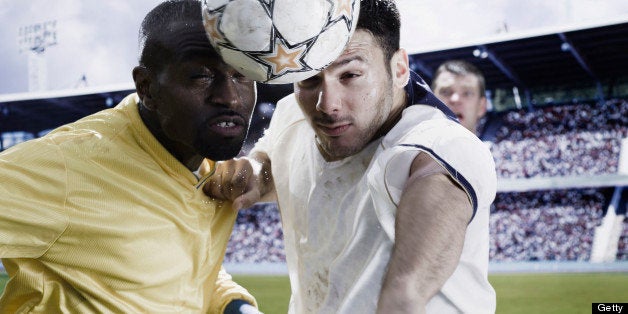
Frequent "heading" -- where a soccer player bounces a ball traveling at high speeds off of his or her head --may be a staple move in the sport, but it may not come without risks, according to a new study.
Soccer players who head the ball frequently score worse on memory tests and even have signs of brain abnormalities like those seen in people who have experienced traumatic brain injury, Albert Einstein College of Medicine researchers found. Their research is published in the journal Radiology.
“Repetitive heading could set off a cascade of responses that can lead to degeneration of brain cells over time," study researcher Dr. Michael L. Lipton, M.D., Ph.D., the associate director of the Gruss Magnetic Resonance Research Center at the college and medical director of MRI at Montefiore Medical Center, said in a statement.
Using a type of brain imaging, researchers were able to track the slightest changes in the white matter in the brains of 37 amateur adult soccer players with a median age of 31, most of whom were men; they had played for an average of 22 years, and spend most of the year playing soccer. Researchers took estimates of how many times each study participant headed the ball in a year.
Frequent headers were found to have low fractional anisotropy (FA), which measures how water moves along the brain's nerve fibers. When white matter in the brain is healthy, FA measures are high, indicating that water is flowing in a uniform way. But when FA levels are low, it's indicative that the water is moving in a more random pattern. Abnormally low FA levels have been linked in the past with thinking troubles in people who have experienced brain injury.
Researchers found that the FA levels were low in certain parts of the brain among the more frequent headers in the study. "The brain findings of the most frequent headers in our study showed abnormalities of white matter similar to what we've seen in patients with concussion," Lipton said in the statement. "Soccer players who headed the ball above a threshold of 885 to 1,550 times a year had significantly lower FA in three areas of the temporal-occipital white matter."
Plus, researchers found an association between more headings and worse memory -- participants who had more than 1,800 headings a year did worse on memory tests, compared with less-frequent headers.
While more research is needed to evaluate the full effects of heading in soccer, researchers noted that it might be prudent to try to limit the amount of heading a soccer player engages in. Researchers noted that in a competitive game, a soccer player may head the ball as many as 12 times, with the ball going at speeds of 50 miles an hour.
A lot of concern in the past decade has cropped up about cause and prevention of brain injury in athletics. A 2010 report in the journal Pediatrics looking at the impact and prevalence of youth soccer injuries detailed research in Norway showing that heading the ball is linked with deficits in memory and attention:
Compared with matched controls, adult soccer players in Norway who began playing soccer in youth leagues (and excluding players with a history of head injury unrelated to soccer) showed mild to severe deficits in attention, concentration, and memory in 81% of the players tested. Players who headed the ball more frequently during competition had higher rates of cognitive loss than players who used the technique less often.